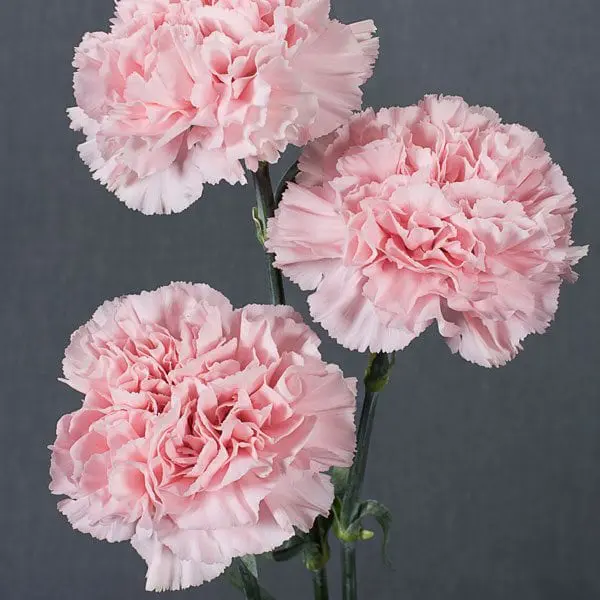The Carnation Flower: A Timeless Symbol of Beauty and Meaning
Carnations (Dianthus caryophyllus) are among the most beloved and versatile flowers in the world, cherished for their frilled petals, rich colors, and delicate fragrance. With a long history of symbolism and use in various cultures, the carnation has earned a special place in the hearts of flower enthusiasts, florists, and gardeners alike. Whether you’re planning a special event, looking for the perfect bouquet, or simply admiring the beauty of nature, the carnation is a flower that has much to offer.
A Brief History of the Carnation
Carnations are native to the Mediterranean region, where they have been cultivated for over 2,000 years. Their name, “carnation,” is believed to derive from the Latin word carnis, meaning “flesh,” due to their original pinkish or flesh-toned color. Another theory suggests that the name comes from corone, meaning “flower garland,” as carnations were often used to adorn crowns and garlands in ancient times.
The ancient Greeks and Romans used carnations in religious ceremonies and to honor their gods, while in the Middle Ages, carnations were prized for their use in medicinal remedies. Over the centuries, carnations have evolved into one of the most popular flowers used in floral arrangements, bouquets, and as decorative plants.
Carnation Varieties and Colors
Carnations come in a wide array of colors, each carrying its own significance. The range of colors is vast, and their distinct hues make them suitable for every occasion, from weddings to funerals. Some of the most common colors of carnations include:
- Red Carnations: A symbol of love, admiration, and respect, red carnations are often associated with passionate emotions and are popular choices for romantic occasions, such as anniversaries and Valentine’s Day.
- Pink Carnations: These are often seen as symbols of gratitude, appreciation, and a mother’s love. Pink carnations are commonly given on Mother’s Day and other occasions where admiration and thanks are expressed.
- White Carnations: Representing purity, innocence, and remembrance, white carnations are often used at memorials and funerals. They are also symbolic of good luck and a deep sense of gratitude.
- Yellow Carnations: The meaning of yellow carnations can vary, but they are generally linked to friendship and joy. However, they can also represent disappointment or rejection, depending on the context in which they are given.
- Purple Carnations: These carnations are often associated with charm and whimsy. They can also symbolize a sense of pride or a deep connection with someone.
- Orange Carnations: Orange carnations typically represent enthusiasm, fascination, and passion. They can be given to show admiration for someone’s energy or spirit.
- Striped Carnations: Sometimes called “broken carnations,” striped flowers can symbolize regret or a feeling of sorrow, but they are also associated with a love that can never be fully realized.
Symbolism of the Carnation
Beyond their beautiful appearance, carnations have held deep symbolic meaning in various cultures and traditions. These flowers have been used to convey emotions, celebrate special moments, and honor significant figures.
- Love and Affection: Carnations, especially the red and pink varieties, are closely associated with love and admiration. Red carnations are often given on Valentine’s Day as a symbol of passionate love, while pink carnations are used to express gratitude and affection. The carnation’s long-lasting bloom also represents a love that endures.
- Motherhood: The pink carnation, in particular, is strongly associated with Mother’s Day, where it has been used as a symbol of a mother’s eternal love and devotion. The tradition of wearing or gifting pink carnations on this day goes back to the early 20th century, thanks to the efforts of Anna Jarvis, who campaigned for the establishment of Mother’s Day in the United States.
- Remembrance: White carnations are often used in memorial services as a symbol of remembrance, honoring those who have passed. They convey purity and the lasting memory of loved ones.
- Mysticism and Spirituality: In some cultures, carnations are thought to have spiritual significance. For example, in Christian symbolism, carnations are believed to have first appeared on Earth when the Virgin Mary shed tears over the crucifixion of Christ. The flower, in this sense, represents a divine connection and compassion.
Caring for Carnations
Whether you’re growing carnations in your garden or simply enjoying a bouquet, proper care can help extend their beauty. Here are some tips for keeping your carnations fresh:
In the Garden
- Planting: Carnations thrive in well-drained soil with a slightly alkaline pH. They prefer a sunny spot and should be spaced around 6-12 inches apart to allow for good air circulation.
- Watering: While carnations need regular watering, it’s important to avoid overwatering. Water them when the top inch of soil feels dry.
- Pruning: Deadheading spent blooms will encourage new flowers to grow and improve the plant’s overall appearance. Carnations also benefit from occasional trimming to maintain a neat shape.
- Fertilizing: Carnations are light feeders but benefit from a balanced fertilizer during their growing season. Too much fertilizer can lead to weak stems and poor flowering, so use it sparingly.
In a Vase
- Water: To keep cut carnations fresh, place them in a vase with fresh, clean water. Change the water every two days to prevent bacterial growth.
- Cutting the Stems: Always trim the stems at an angle before placing them in water. This helps the flowers absorb more water and stay hydrated.
- Location: Keep carnations in a cool area, away from direct sunlight and ripening fruit (which can emit ethylene gas that accelerates wilting).
- Longevity: Carnations are known for their longevity compared to other flowers. When properly cared for, they can last up to two weeks in a vase.
Uses of Carnations
Carnations are versatile flowers that can be used in various settings and occasions. Their long-lasting nature makes them ideal for both personal and professional arrangements.
- Weddings: The elegant and romantic look of carnations makes them a popular choice for wedding bouquets and centerpieces. They can also be used to create boutonnieres and corsages for the wedding party.
- Mother’s Day: Pink carnations are the perfect flower for Mother’s Day, often used in both bouquets and floral arrangements to show gratitude and affection.
- Funerals and Memorials: White carnations, often associated with remembrance, are commonly seen at funerals or memorial services, honoring the memory of loved ones who have passed.
- Everyday Occasions: Carnations are ideal for any occasion, from birthdays to anniversaries to housewarmings. Their beautiful range of colors and lasting beauty makes them a wonderful way to brighten someone’s day.
Conclusion: The Enduring Charm of the Carnation
From their rich history to their symbolic meaning, carnations are much more than just beautiful flowers. They are timeless symbols of love, gratitude, remembrance, and joy. Whether you’re planting them in your garden, arranging them in a bouquet, or gifting them to someone special, carnations are a flower that can bring both beauty and meaning into any space or occasion.
So the next time you’re picking out flowers for a bouquet, consider the elegance of the carnation — a flower that’s not only lovely to look at but also carries with it a deep cultural significance and a lasting legacy.



